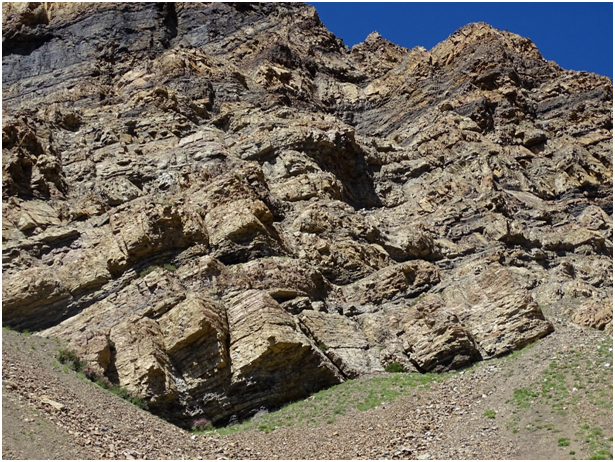Giumal Fm
Type Locality and Naming
Named after Giumal village in Spiti. [Original Publication: Stoliczka, F. 1865. Geological section across the Himalayan mountain range from Wangtu Bridge on the river Sutlej to Sungdeo with an account of formations in Spiti accompanied by a revision of all known fossils from that district. Memoirs of Geological Survey of India, 5: 153p]
Synonyms: Guimal Sandstone.
[Figure: Zanskar-Spiti-Kumaun region location (provided by Om Bhargava)]
Lithology and Thickness
Sandstone. Comprises successions of grey to creamish sandstone, separated by decimeter-thick oolitic interbeds. 300-400 m in Giumal village, Spiti;
[Figure 1: Field photograph showing the outcrop of the Giumal Sandstone in Spiti near the village Giumal (photo loaned by R.S. Chaubey)]
Relationships and Distribution
Lower contact
Gradational contact with the underlying Spiti Fm.
Upper contact
Sharp contact with the overlying Chikkim Fm.
Regional extent
Zanskar-Spiti and Himachal Pradesh to Kumaun-Garhwal region of Northwest Tethyan Himalaya
GeoJSON
Fossils
Planktonic foraminifera resembling Hedbergella delrioensis (in black shale). Holostephanus (Astieria) aff. atherstoni, Stephanoceras sp., Perisphinctes sp., Cardium gieumalense, Pseudomonotis superstes and Gryphaea aff. baylei bivalves; belemnites.
Age
Depositional setting
The Giumal sandstone reflects the multiple progradation of clastic detritus brought by deltaic systems onto a shelf influenced by storm-wave action or tidal currents (Bhargava and Bassi, 1998; Gaetani et al., 1986).
Additional Information

